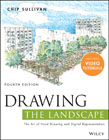
This elegant Fourth Edition of Chip Sullivan?s classic Drawing the Landscape shows how to use drawing as a path towards understanding the natural and built environment. It offers guidance for tapping into and exploring personal creative potential and helps readers master the essential principles, tools, and techniques required to prepare professional graphic representations in landscape architecture and architecture. It illustrates how to create a wide range of graphic representations using step–by–step tutorials, exercises and hundreds of samples. INDICE: Preface vii Preface to the Third Edition ix Acknowledgments xiii 1 The Essence of Drawing 1 Definition of Drawing 3 Drawing as Conceptualizing 7 Drawing as Seeing 7 Freedom and Structure 12 The Power of Drawing 16 The Spirit of Drawing 17 2 The Daybook 19 Types of Daybooks 27 Media 29 Mixed Media 31 Doodles 32 Daybook Variations 33 3 The Creative Environment 43 The Studio 44 The Artistic Community 50 Inspiration 56 The Creative Process 60 4 Equipment and Drawing Instruments 65 Equipment 66 The Pencil 69 Drawing Paper 72 Soft Media 73 Pen and Ink 76 Technical Pens 77 Colored Pencils 80 Watercolor 84 5 Preliminary Drawing Exercises 93 Holding the Drawing Instrument 94 6 Tone and Texture 111 Light, Shade, and Shadow 112 Tone and Value 113 Hatching 114 Crosshatching 115 Chiaroscuro 116 Light 116 Shadow 117 Basic Solids in Tone 119 Texture 122 7 Drawing Techniques for Trees and Plants 131 Contour Drawing 133 Gesture 136 Plant Forms 137 Plant Structure 137 Foliage 140 Shadow 147 Tree and Plant Massing 154 8 Composing the Landscape Drawing 157 The Picture Plane 162 Drawing Paper 164 The Classic Landscape Composition 169 Optical Devices 171 9 Freehand Perspective Drawing 181 Linear Perspective 183 Freehand Landscape Perspective 186 Horizon Line 187 Viewpoints and Vanishing Points 189 Proportional Relationships 191 Developing the Gestural Quality of Freehand Perspective 200 Architectural Perspective 203 10 Drawing the Landscape in Plan, Elevation, and Section 207 The Landscape Plan 209 Frame of Reference 211 Scale 212 The Freehand Conceptual Plan 216 The Measured Plan 218 Ground Plane Treatments 219 Ground Plane Textures 220 Water 221 Architecture 224 Trees and Vegetation 225 Shadows 227 The Elevation 228 The Section 230 Illustrating the Elevation and Section 231 Elevation Perspective 233 11 Axonometric and Isometric Landscape Drawing 235 The Axonometric 239 The Isometric 242 Freehand Bird’s–Eye 243 The Exploded View 244 Illustrating the Axonometric and Isometric 246 Composing the Paraline Drawing 250 12 Animating the Landscape: Visual Narratives, Storyboards, and Moving Drawings 251 The Figure in Space 252 Comics and the Visual Narrative 259 Storyboarding the Landscape 263 Moving Drawings: Animating the Storyboard 271 13 The Hybrid Drawing 275 The Joy of Graphite 277 Embellishing the Wireframe 280 Digital Rendering Techniques 281 Drawing over Photographs 285 The Cézanne Effect and the Impressionist Image 286 Techniques of Sequential Artists 288 Tea and Coffee Cocktail Washes 291 The Scanned Wash 291 Special Effects for Texturing Digital Prints 292 Overpainting with Oils 293 The Tableau 294 Summary 297 14 The Art of Presentation 299 The Mock–up 302 Lettering 309 The Competition Drawing 310 Experimental Media: A Gallery of Ideas 312 Conclusion 319 Afterword 323 References 325 Index 327
- ISBN: 978-1-118-45481-7
- Editorial: John Wiley & Sons
- Encuadernacion: Rústica
- Páginas: 352
- Fecha Publicación: 16/01/2014
- Nº Volúmenes: 1
- Idioma: Inglés
